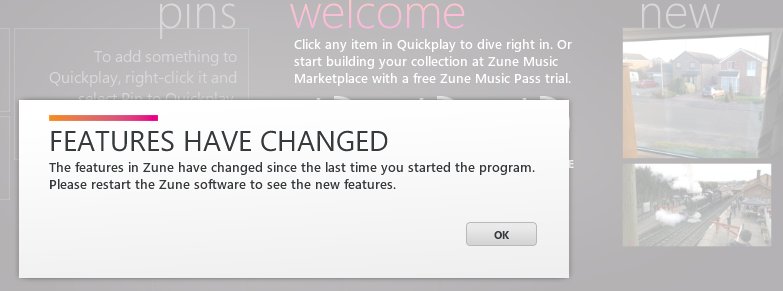First we need to decide what functions still need to make the jump from the Zune PC suite to work on Windows Phone devices (and which need a bit of improvement). That gives us a current baseline of "standalone", and at the same time helps to see where the gaps are - gaps which will hopefully be filled in as Windows 8 arrives later in 2012.
The biggest current use of Zune PC, that is key to the platform in my opinion, is for firmware updates, the push alert on the handset asking people to connect up to Zune PC for the latest firmware is something many of us will already be familiar with. There's actually very little that needs doing here, as the Windows Phone platform has the ability to do Over The Air firmware updates direct to the handset - it's just never been used.
I suspect that's down to support issues, as Zune PC will kick off a full backup and restore as part of the update process, giving a bit of safety in case anything goes wrong. And there's my first element I want to see. Backup and Restore settings, save files, and all data from my Windows Phone. Even if it is just a single archive file on the SkyDrive storage system. With that in place, I think it's a fair bet that Over the Air Firmware updates will arrive soon.

Music organisation on your smartphone is one of the big benefits of using the Zune PC suite, and that's something that needs thought through if the PC Suite is to be decoupled. The playlist editing capabilities on Windows Phone devices is rudimentary at best, allowing you to build up a "now playing" list and then save that as a separate playlist. This needs some improvement on the handset, before we can lose that ability from the desktop.
And much as it pains the accountants, you can't rely on everything being bought and downloaded from the Windows Marketplace. Some form of music storage locker is going to be needed in the cloud, and that's going to tax the legal minds in terms of licensing. So there will need to be an option to move media files (both audio and video) from the desktop to the handset and back again. I don't see everything being forced through the main cloud, but an extension of the Wi-Fi synchronising tools in Zune would fit with the existing architecture, preserving that route for files such as personal HD video recordings, while still sharing an untethered lifestyle, is the likely route. And yes, that means some sort of thin client on the desktop.
The broad strokes of Wi-Fi Sync and SkyDrive show that the building blocks are coming online, and it wouldn't surprise me that they are all timed to be in place and operational for Windows 8 arriving on our handsets.

Many elements are already there - the majority of PIM support is already cloud-enabled, either through Hotmail/Windows Live or your Google Account. The Marketplace for Applications, even before the removal of the Zune PC Suite support, was already cloud-based, with any web browser able to push application installs to your phone. And of course the supporting of accounts on other social networks (such as Facebook) shows the thinking of online cloud support that is already baked into the OS.
Perhaps some people weren't ready for a totally cloud-based phone when Windows Phone was being designed, but the framework is there in the code. Now that people are starting to catch up, and it's a less scary prospect than 24 months ago, it's time to start transitioning everything off the desktop and bringing the new features online, one by one.
And every time that happens, Windows Phone gets a little bit more interesting, more capable, and closer to the platform Redmond has envisioned. I can't wait to get there.
